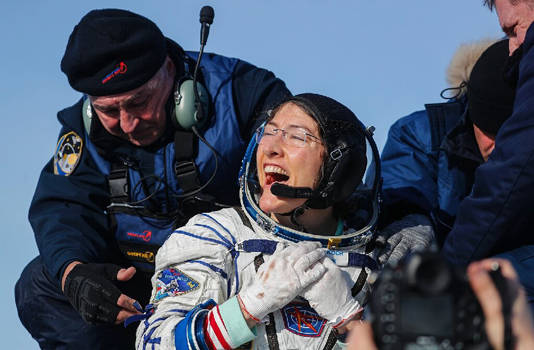ALMATY, Kazakhstan, Feb 7, 2020 (BSS/AFP) – NASA’s Christina Koch returned
to Earth safely on Thursday after shattering the spaceflight record for
female astronauts with a stay of almost 11 months aboard the International
Space Station.
Koch touched down at 0912 GMT on the Kazakh steppe after 328 days in
space, along with Luca Parmitano of the European Space Agency and Alexander
Skvortsov of the Russian space agency.
Koch was shown seated and smiling broadly after being extracted from the
Soyuz descent module in the Roscosmos space agency’s video footage from the
landing site.
“I am so overwhelmed and happy right now,” said Koch, who blasted off on
March 14 last year.
Parmitano pumped his fists in the air after being lifted into his chair
while Skvortsov bit into an apple.
US President Donald Trump congratulated Koch on Twitter.
“Welcome back to Earth, @Astro_Christina, and congratulations on breaking
the female record for the longest stay in space! You’re inspiring young women
and making the USA proud!” he tweeted.
Local Kazakhs on horseback were among those to witness the capsule landing
in the snow-covered steppe as support crews gathered around the three
astronauts, NASA commentator Rob Navias said.
“I’ve never seen this,” Navias exclaimed, reporting that the men stopped
to chat with engineering personnel.
Koch, a 41-year-old Michigan-born engineer, on December 28 beat the
previous record for a single spaceflight by a woman of 289 days, set by NASA
veteran Peggy Whitson in 2016-17.
Koch called three-time flyer Whitson, now 60, “a heroine of mine” and a
“mentor” in the space programme after she surpassed the record.
She spoke of her desire to “inspire the next generation of explorers.”
Koch also made history as one half of the first-ever all-woman spacewalk
along with NASA counterpart Jessica Meir — her classmate from NASA training
— in October.
The spacewalk was initially postponed because the space station did not
have two suits of the right size for women, leading to allegations of sexism.
Ahead of the three-and-a-half hour journey back to Earth, Koch told NBC News
on Tuesday that she would “miss microgravity”.
“It’s really fun to be in a place where you can just bounce around between
the ceiling and the floor whenever you want,” she said, smiling as she
twisted her body around the ISS.
Koch will now head to NASA headquarters in Houston, via the Kazakh city of
Karaganda and Cologne in Germany, where she will undergo medical testing.
Koch’s medical data will be especially valuable to NASA scientists as the
agency draws up plans for a long-duration manned mission to Mars.
– ‘Make space for women’ –
Koch’s return comes after an advert for a skincare brand ran during an
intermission in the American football Super Bowl with a call to “make space
for women”.
The advert featured NASA astronaut Nicole Stott and saw the company
promise to donate up to $500,000 to the non-profit Women Who Code, which
works with young women seeking careers in tech and scientific fields.
The first woman in space was Soviet cosmonaut Valentina Tereshkova, whose
spaceflight in 1963 is still the only solo mission carried out by a woman.
Russia has sent only one woman to the ISS since expeditions began in 2000
— Yelena Serova whose mission launched in 2014.
Both Tereshkova and Serova are now lawmakers in the Russian parliament,
where they represent the ruling United Russia party.
Unlike Koch, whose ISS stay was extended, Parmitano and Skvortsov were
rounding off regular half-year missions.
Parmitano handed over command of the ISS to Roscosmos’s Oleg Skripochka on
Tuesday.
The 43-year-old Italian posted regular shots of the Earth while aboard,
highlighting the plight of the Amazon rainforest and describing the Alps as
“like a spinal column, never bending to time”.
Four male cosmonauts have spent a year or longer in space as part of a
single mission with Russian Valery Polyakov’s 437 days the overall record.
Scott Kelly holds the record for a NASA astronaut, posting 340 days at the
ISS before he returned home in 2016.



